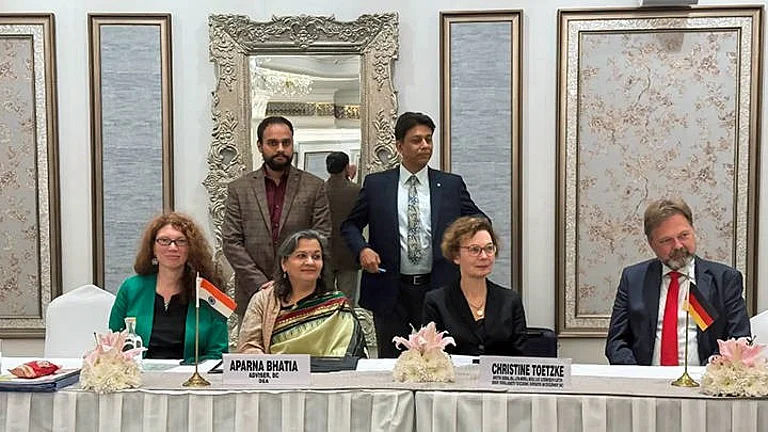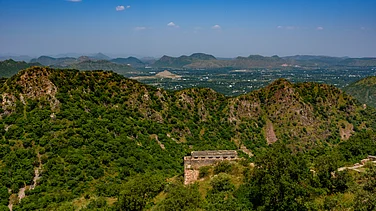Last June, as Delhi baked under a brutal sun, the city turned deadly. In just a few days, over 230 people, most of them homeless, were silently swallowed by a heatwave that turned the capital into a boiling cauldron. Mumbai and even balmy Bangalore fared no better, with temperatures soaring to all-time highs and taps running dry. To the east, widespread power cuts plunged a searing Kolkata into sweaty darkness. All across India’s changing demographic landscape, a human crisis is brewing as millions of people, driven by socio-economic pressures, migrate from villages to its beleaguered cities, bursting at their infrastructural seams.
“Indian cities are deeply vulnerable to climate change, and we’re already witnessing the consequences. These aren't distant threats; they’re happening now, and they must shape how we think about urban planning and resilience going forward,” says Viral Thakker, Partner and Leader Sustainability and Climate, Deloitte, South Asia.
The fact is that India no longer lives in its villages — at least, not nearly as much as it used to in 1960, when eight out of 10 of its people resided in the countryside. Indian cities are now home to 50 crore people, more than the country’s entire population of 44 crores in 1960. By 2050, 60% of its projected 160-crore population, or close to 100 crore people, is expected to have an urban address—roughly as much as the combined population of the United States, Indonesia, Russia, and Japan.
In a business-as-usual case, together Indian cities will consume 70% of the country’s primary energy, spew 60% of its greenhouse gases and drive 75% of the country’s GDP by 2050.
Experts like Thakker, therefore, rightly believe that India’s fight for a net-zero future will be won or lost in its urban battle-grounds.
The Urban Climate Dilemma
In a recently published study Nature, a leading science journal known for cutting-edge research and expert commentary across disciplines, observes that while climate change is heating up all regions of the planet, the temperatures of its cities are rising at a significantly higher rate. Cut to India, its cities are warming at an average rate of 0.53°C per decade, with the process of urbanisation —spread of concrete, reduction in green cover, and rising energy use—alone contributing to 0.2°C of that rise. Consequently, the country’s urban expanses are experiencing about 37.7% more warming than nearby non-urban regions.
“India’s rapid and uneven urbanisation — concentrated in a few large cities — has intensified climate-related challenges. Poor public transport, rising private vehicle use, and loss of green cover have increased emissions and worsened the urban heat island effect,” says Abhishek Saxena, Former Public Policy Expert at Niti Aayog. “As cities grow without climate-sensitive planning, they become more vulnerable to extreme heat, pollution, and other climate shocks, especially affecting low-income populations.”
Blueprint for Urban Transition
According to the latest report from the Department of Environment, GNCTD, Transport (47%) and Road Dust (20%) are the two largest urban emitters. Electric vehicles, particularly for mass public transport, offer a clear advantage over internal combustion engine (ICE) vehicles — but India’s urban transit systems are still relatively underdeveloped.
Take Delhi, for instance. The city has just 6,000 buses, well short of the 11,000 recommended in a 2015–2017 report. Last-mile connectivity remains a weak link. While its world-class metro network helps, rising ticket prices have made it unaffordable for low-income commuters, forcing them to depend on buses.
Large parts of cities like Mumbai and Bengaluru still lie outside the limited reach of their metro networks. Mumbai’s BEST, which once lived up to its name, as a public bus system, has witnessed a steady decline, both in quality and reach. However, the introduction of electric buses under the OPEX model in the city offers a ray of hope — enabling procurement and operations without placing a heavy capital burden on the public transport utility.
In a warming world, efficient and comfortable bus systems aren’t a luxury; they are a necessity that could herald a shift to emission-free urban transportation at least by 2047, when India hopes to join the ranks of the world’s developed economies. “Cities like Beijing and Shanghai have shown how a strong EV transition can lead to visibly cleaner skies — a transformation that India too can aspire to achieve with focused effort,” says Thakker of Deloitte.
Water & Waste
In largely services-based urban agglomerations, waste spirals in direct proportion to growing populations and incomes, which spur consumption, many a time excessively, leading to an unsustainable pile-up of municipal, plastic and electronics waste. Massive output of ash, dust and debris from uncontrolled construction and demolition activities add to the urban nightmare, chocking storm-water drains, leaching toxic chemicals into soil and groundwater and releasing methane and other GHGs into the atmosphere. Despite several regulatory interventions and city initiatives, urban India continues to churn out roughly 200 to 250 million tons of waste across these four categories every year.
“Apart from stressing already overstretched civic infrastructures, the waste management crisis poses dreadful environmental and public health risks. Just the cost of mitigating the health impact could drown the sustainability ambitions of the country,” says Abhishek.
Depleting groundwater is just as big a problem as rainfall patterns becoming increasingly erratic due to climate change. A city like Mumbai has seven to eight reservoirs supplying water. Not all cities, however, are that fortunate. Natural reservoirs like lakes and water bodies have all but dried up in most of them, increasing the reliance of their swelling populations on diminishing groundwater, and setting the stage for a water crisis. Sample this for a sense of the problem: Bengaluru had 900 lakhs just 40 years back, of which only 200 have survived indiscriminate urbanisation, many of which, like the famed Ulsoor Lake, are choked by silt and untreated waste.
“Gurgaon and Bangalore are at particularly grave risk,” says Thakker. Citing a recent Central Groundwater Board report, he points out that the Millennium City extracts groundwater twice as fast as nature can replenish it. The figure for Bangalore stands at 1.87 times. Excessive groundwater extraction not only harms tree cover by disrupting underground water availability, but can also lead to land subsidence — a gradual sinking of the ground surface. This lowering of the land can trigger a host of other structural and environmental problems.
Construction and demolition
As India pushes towards its development goals, it must balance the massive infrastructure it needs with its crucial sustainability goals. Studies estimate that nearly 66% of the infrastructure and buildings India will need by 2050 have yet to be built. In other words, the country will have to triple what it has already built to realise its "Viksit Bharat” vision.
For this, “India must focus on clean construction processes, revolving around green concrete and green cement, and foster innovation that minimises the environmental footprint of construction,” says Abhishek. It is equally important to preserve natural assets like forests, wetlands, open spaces, and traditional water bodies such as tanks and ponds, which act as natural buffers during extreme rain and storm-water events.
“Alongside green construction, India’s urban growth needs to be supported by strong, well-planned infrastructure. Beyond building more roads, cities need coordinated and efficient metro systems and public transport networks that can seamlessly shift people away from private vehicles and reduce emissions,” says Himani Jain, Senior Programme Lead, CEEW.
India’s tryst with policies
India has taken several steps with varying degrees of success to make its cities climate-resilient and sustainable, including the Smart Cities Mission, which took off in 2015 with the purpose of leveraging technology to drive urban growth, improve resource management and enhance urban mobility and service delivery. The mission has so far attracted 5,000 projects from 100 cities worth Rs 2,05,018 crore, funded through a combination of central, state, and local government sources. Public-private partnerships have also been tapped.
Despite a sluggish start, 2,148 schemes were completed at a cost of over Rs 35,000 crore by 2020, many of them focused on promoting sustainability, resilience, and inclusivity. These included "smart" command and control centres in 53 cities, 84 water management and 47 solar energy projects. Complementing these efforts was the rollout of the National Mission on Sustainable Habitat 2021–2030, designed to promote low-carbon urban growth and strengthen the resilience of cities to climate impacts. To monitor and encourage improvements in urban living standards, the government introduced the Ease of Living Index in 2018, which measures and tracks the liveability of cities across various parameters.
While the Smart Cities Mission has ushered in visible improvements in urban infrastructure and governance in some cities, such as Surat and Indore, its overall impact has been patchy. Save a few notable exceptions, most of the 100 designated cities continue to grapple with projects delayed by poor coordination, funding bottlenecks, and limited local capacity. Critics argue that despite its technological focus, the mission has often fallen short on inclusivity and long-term sustainability. Independent assessments stress the need for better stakeholder engagement, stronger accountability, and a shift from project-counting to people-centric outcomes if the initiative is to meet its transformative potential.
Execution roadblocks and the cost of inaction
Since it is crucial for cities to enable both climate mitigation and adaptation, India’s 4800 Urban Local Bodies (ULBs) LBs need to build their plans around climate goals, or, in other words, develop City Climate Action Plans (CCAPs). But so far only a handful of cities have like Mumbai, Ahmedabad and Junagadh have achieved this.
The biggest hurdle for most ULBs is the lack of financial devolution. “The 73rd and 74th Constitutional Amendments may have empowered panchayats and municipalities on paper, but the funding to back the empowerment is missing,” says NitiAayog’s Saxena. “Most Indian cities still depend heavily on state governments for finances — and states are often politically disincentivised to strengthen local bodies.”
Experts argue that municipal corporations must be allowed to raise their revenues through mechanisms like property taxes, advertising, and other sources. Another hurdle is the paucity of planning capacity and technical resources at the municipal level. Local bodies are often stretched thin, with nearly 40% of their funds going toward basic services like waste collection. Without additional support, long-term urban planning and climate resilience efforts will remain out of reach. India’s future hinges on how it shapes its cities today.
“The Union government must accelerate decarbonisation by investing in cities that are compact, connected, clean, and inclusive, helping drive sustainable growth while improving quality of life,” says Thakker. A bold and comprehensive national urban development plan is essential to ensure that policies and schemes are implemented effectively and on time.
Urban growth must pivot on affordable housing, reliable basic services, and the upgradation of slum areas, making cities livable and inclusive for all. Says Dr Vishwas Chitale, Senior Programme Lead, Council on Energy, Environment and Water (CEEW): “The development plans must achieve a critical balance between the actions on climate change adaptation and mitigation, ensuring that the cities in India are better able to deal with climate change impacts such as floods and heat waves.”
Building resilience to climate change is just as urgent as reducing emissions. Strengthening this resilience will require a multifaceted approach that includes embedding climate considerations into infrastructure and urban planning, adopting new technologies and practices to mitigate risks, and addressing socio-economic vulnerabilities to protect cities against climate shocks.. As a recent editorial in Nature emphasised, “resilience must be treated as a core pillar of climate action, not an afterthought.” India’s metros stand at a crossroads. Whether they drive or derail the country’s climate ambitions depends on how boldly and urgently we act today — before rising heat and chaos become the new normal.































